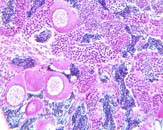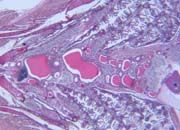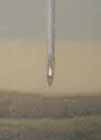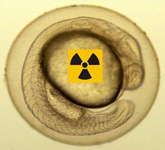

Home > Research
Research

Current area of research is on:
Effects of endocrine disruptors
Determination of the oxygen demand of fish embryos
Trans-generational effects of PFOS
Causal analysis of the fish decline of the Danube River
Calcium regulation in permanernt fish cells
Development of a flow-through system for the Fish Embyo Test
Optimization of the Fish Embyo Test
Radioactive analytic of pollutant effects in the Fish Embryo Test
Classification of sediment samples by fuzzy logic
Effects of endocrine disruptors on the hormonal system of aquatic vertebrates
Endocrine disruptors are substances which alter functions of the hormonal system and lead to negative effects on health and reproduction of intact organisms, their offspring or their sub-populations.
Aquatic organisms are particularly susceptible, since their natural habitats are the major sink for pollutants. In our group, apart from amphibian larvae, mainly fish are being studied.
The aim of the tests is to identify the endocrine potential of the test substance via various end points. Among those, histopathological and ultrastructural alterations in the corresponding tissues or changes in the hormone concentrations or of vitellogenin the blood are of particular concern.


Microplastics in the aquatic environment
Microplastics have grown to a major focus of environmental pollution research in the last decade. Central questions in this topic include a) the potential to harm aquatic organisms per se (e.g. mechanically) after being taken up as putative food resource, and b) if associated persistent organic pollutants (POPs) are being transferred along with microplastics uptake and thus represent an additional pathway to toxic exposure.

The oxygen consumption of zebrafish (Danio rerio) embryos and the oxygen depletion by sediments are determined. For this end, the oxygen demands of the embryos and the depletion of oxygen by various sediments are assessed, thus allowing an estimation of the minimum oxygen levels required for the undisturbed development of embyros lying directly on sediments. These aspects are particularly relevant in the sediment contact test, where the eggs are in direct contact with the sediment and, therefore, are highly susceptible to potential declines of the concentration of oxygen in the supernatant solution.
The fish embryo sediment contact test is based on a protocol derived from the generic Fish Embryo Test protocol, which simulates a micro-habitat consisting of a sediment and a water phase, thus closely resembling the actual natural conditions. With this setting, sediments can be studied more realistically regarding to their toxicity than with any other test system. The measuring instruments are based on physical-optical principles not consuming any oxygen during the measurements.

In cooperation with:

GenTEQ: Standardization of DNA damage data
The aim of this project is the effect-assessment of single substances or complex environmental samples, respectively, by implementing a reference substance into the protocol, allowing the normalization of experimental data (via reference to the standard compound) in a simple and comparable way as so-called GenTEQ (GenoToxicity EQuivalent Concentration) values. To this end, several substances known as positive controls for genotoxic effects are being analyzed in the Comet and Micronucleus assays, thus allowing the determination of their suitability to generate reproducible results . A most important aspect turned out to be the reproducability of the measurements, which is a prerquisite for high quality data and the significance of the results obtained.
Perfluorinated Tensides
Perfluorinated tensides (PFTs) constitute a group of fully fluorinated synthetic compounds which is widespread in industrial and commercial products. PFTs are considered persistent and are being detected in environmental samples around the globe including drinking water and humans.
The use of perfluorooctane sulfonate (PFOS), one of the major PFT found in the environment, is facing a legislated restriction within EU from June 2008. Perfluorobutane sulfonate (PFBS) is one of the potential substitutes although the toxicology of this compound is far from satisfactory.
Despite extensive conservation programs and improved water quality, the fish populations in the upper Danube River between Sigmaringen and Ulm have declined significantly since the 1980s. A high ecotoxicological potential has been found in sediments from the Danube River during a pilot study. As a result of this study, a weight-of-evidence study was initiated in order to identify the reasons for the fish decline and the major contamination sites. For this end, a biotest battery was used to assess the damaging potential of sediment extracts and native sediments. In addition, ultrastructural changes in the liver of European barb (Barbus barbus) were examined. Mutagenic effects in barbs were determined by the micronucleus assay with erythrocytes. Furthermore, in addition to classic limnological parameters, concentrations of heavy metals and primary organic pollutants (PAHs, PCBs and PCDD/Fs) were measured in sediments.
(Description will be provided soon)
(Description will be provided soon)
Within the framework of developing and validating an OECD test guideline for the Fish Embryo Test (FET) as an alternative method for the acute fish toxicity test, several substances have been identified which led to significantly different results in the fish embryo and fish toxicity test. Now, the effect of the chorion upon the uptake and accumulation of chemicals in the fish embryo test is being examined by dechorionization experiments, especially for substances whose in vivo- and in vitro-results are correlating only poorly. By prolongation of the duration of the Fish Embryo Test and analysis of mechanisms of action, we also investigate if there are certain modes of toxic action, which cannot be revealed by the Fish Embryo Test.
In cooperation with the Institute for Environmental Research, RWTH Aaachen, the distribution of four radioactively labelled substances with different octanol-water distribution coefficients (log KOW) over various compartments of the fish egg (chorion, perivitelline space, embryo) and the exposure vessels was determined. The experiments were performed in multi-well plates made of polystyrol and glass. Additionally, the substances were introduced via spiked sediments. The radioactivity of the sediments was determined by combustion with the aid of an oxidizer. In parallel to the experiments, the bioavailability of the substances in the wells was analyzed using the solid phase microextraction (SPME).

In cooperation with:

Integrated assessment and comparison of sediment contamination in Brazil and Europe
The Tietê River basin, the largest hydrographic basin of São Paulo State (Brazil), receives high loads of organic pollutants in its reservoirs, derived from domestic sewers, industrial residues, agricultural and agro-industrial activities, and inorganic substances of industrial sources. Reservoirs are complex aquatic systems, intermediating between rivers and lakes, and usually reflect all the impacts generated by a variety of anthropogenic activities taking place inside the hydrographical basin they are inserted. Aquatic sediments are able to accumulate toxic chemicals, thus, acting as a deposit and, in certain circumstances (e.g. sediment remobilization associated to flood events), as a source of pollutants in to water column. In this study, a set of natural sediments collected from Tietê River Basin reservoirs has been investigated by a combination of environmental chemical and ecotoxicological approaches using laboratory studies, acute and mechanism-specific in vitro biotests and investigations in situ.
In cooperation with:

Classification of environmental samples by fuzzy logic
Integrative assessment approaches generate a multitude of data with varying endpoints, which cannot be easily analyzed and interpreted due to the complex interdependencies of the variables. Especially for persons less familiar with the subject, e.g. regulators in government agencies, it is critical to aggregate the results originating from such complex correlations in a way which alows the simple assessment of - for example - contaminated sediments. For this end, the reduction of complexity of the analyzed parameters without losing substantial information is necessary. Therefore, there is a great need for assassment and classification of contaminated sediments when aggregating data from comprehensive assessment approaches.
Usually, only samples originating from a single river basin are analyzed for the assessment resp. classification, which can later cause problems when comparing these results with those from other rivers and streams: The classification system is usually dependent on a geographical localization. As a result, it is important to develop a concept based on several statistical methods, permitting the aggregation of data from different projects for a geographically independent assessment.
The fuzzy technology allows the integration of expertise, the combination of different types of data, for example chemical contamination in mg/kg, percent inhibition as well as uncertainty of biological parameters and the possibility to enter the correlations into a model in a linguistic format creating a system which is able to take account of the complexity and uncertainty of experimental data, but still remains transparent also for non-mathematicians by incorporation of linguistic elements. For this purpose, among others, fuzzy logics are increasingly applied in environmental analyses as an assessment instrument for contaminated sediments.